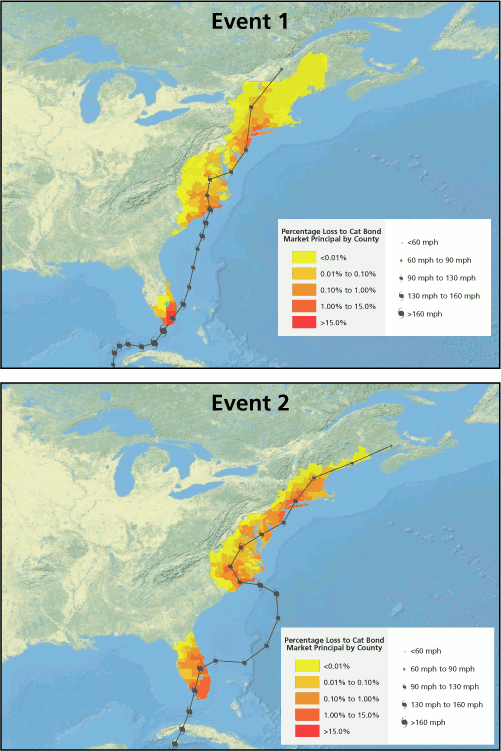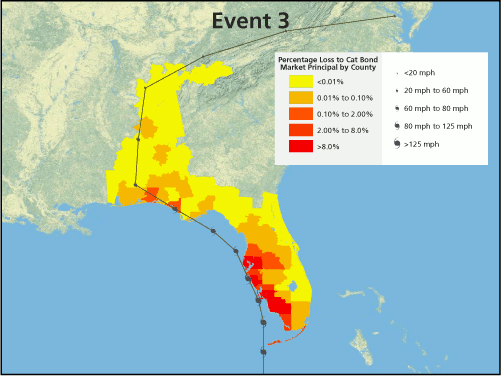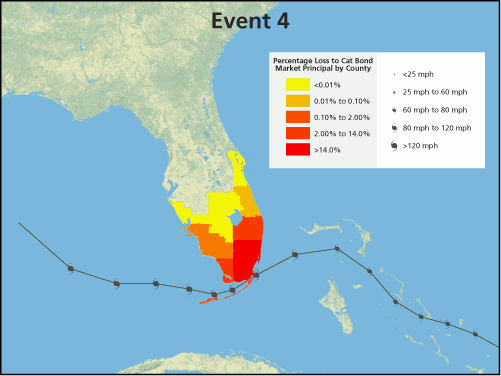A single Category 5 hurricane making a number of landfalls on the U.S. coastline, including impacting Miami and New York, could wipe out as much as 60% of catastrophe bond tranches, according to analysis from risk modeller AIR Worldwide.
AIR Worldwide risk consultant Justin Pierce takes a look at the modelled events in AIR’s dataset which, if they occurred, would have the largest impact on the outstanding catastrophe bond market. His analysis looks at four simulated events, two powerful modelled hurricanes and two weaker storms which are still impactful to cat bonds, and the impact that their modelled losses would have on current cat bonds.
U.S. wind or hurricane risk makes up a large proportion of the current catastrophe bond market, making up as much as 64% to 70% of cat bond risk capital currently at risk. As a result it is important for investors to understand the potential ramifications of worst case scenario catastrophe events on their portfolios and the cat bond market.
The analysis first looks at these two Category 5 hurricanes, both of which take a similar track and have similar intensity, and compares the potential impacts to the cat bond market.

Hurricane Events 1 and 2 which have similar tracks and intensity - Source: AIR Worldwide
The first, Event 1, is the single hurricane simulation which would cause the largest loss to the cat bond market in AIR’s database of storms. It is a 1 in 10,000 year event, with an exceedance probability of just 0.01%. It makes landfall in Monroe County, Florida, before slamming Miami, then hitting North Carolina and finally New York and New Jersey area.
Event 1 would cause an insurance industry loss of around $385 billion, according to AIR Worldwide, making it the most financially damaging hurricane ever. The storm would trigger 68% of catastrophe bond tranches in the market today and would cause a massive 60% of principal loss to the cat bond market.
Interestingly, the second event which has similar track and intensity, is much less damaging. This Cat 5 hurricane has an exceedance probability of 3.84%, would cause a market insured loss of around $54.9 billion and would trigger 21% of cat bond tranches in the market while causing just over 12% of cat bond principal loss.
While Event 1 is a rare, worst case scenario storm, Event 2 is well within the realm of possibility for a typical hurricane season. For a $54.9 billion insured loss to result in 12% of cat bond market principal loss is an eye-opening statistic and one which investors should consider carefully when allocating capital into the cat bond market.
The analysis says that the difference between the two storms is in the concentration of properties affected. This is the factor which impacts how big the loss is to the cat bond market. This is why storm tracks are so carefully watched by ILS investment managers, as slight deviations into regions of greater insured property density can make a big difference to the losses faced.
Event 2 misses Miami-Dade, Palm Beach and Broward counties, where as Event 1 makes a direct hit on them. This reinforces the feeling that a major Miami hurricane is one of the largest potential loss events for the catastrophe bond market.
Weaker hurricanes are still capable of causing a significant loss to the catastrophe bond market, shows AIR Worldwide’s analysis. AIR looks at two lower category hurricanes, both of which cause a significant loss to the cat bond market.

Hurricane event 3's track - Source: AIR Worldwide
Hurricane Event 3 is a Category 1 storm which at first glance may not appear likely to seriously threaten the catastrophe bond market, but it would cause 33% of tranches to be triggered and a 19% loss of principal to the market, according to AIR’s analysis. This is a larger loss to cat bonds than the Event 2 Cat 5 hurricane which is surprising and again shows the importance of the track to the eventual loss.

Hurricane event 4's track - Source: AIR Worldwide
The final hurricane, Event 4, is a Category 3 storm which bypasses Florida and does not make a direct landfall at all. However due to the track and the winds passing over concentrated areas of value at risk this storm also creates a large loss to cat bonds.
Event 4 would cause 26% of cat bond tranches to be triggered and a loss of principal to the cat bond market of roughly 21%. Again, this is a little surprising, given the lower strength and the track compared to Event 2, but further reinforces the importance of the track in causing the loss to the cat bond market.
It’s a fascinating piece of analysis, which you can read in full here. It really drives home the fact that the impact a hurricane could have on the catastrophe bond market cannot be fully understood until we know the exact track a storm has taken. This has implications for secondary trading, or live cat trading, of cat bonds as storms approach, because you really cannot fully predict the impact on exposed cat bonds until the storm is much closer to land and its eventual track is better understood.
 View all of our Artemis Live video interviews and subscribe to our podcast.
View all of our Artemis Live video interviews and subscribe to our podcast.
All of our Artemis Live insurance-linked securities (ILS), catastrophe bonds and reinsurance video content and video interviews can be accessed online.
Our Artemis Live podcast can be subscribed to using the typical podcast services providers, including Apple, Google, Spotify and more.































